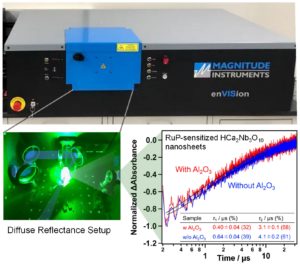Learn how advances in noise suppression technology now make it easy to measure transient diffuse reflectance spectra of photocatalytic systems under realistic conditions in the enVISion TA spectrometer.
Transient Diffuse Reflectance Spectroscopy: Applications in Photocatalysis
Table of Contents
ABSTRACT: Transient diffuse reflectance spectroscopy enables the investigation of photoelectrochemical reactions and intermediates at catalyst surfaces. The technique has historically been challenging to implement because of the low probe light intensities associated with diffuse reflectance along with interference from laser scatter and photoluminescence from the sample. Recent innovations in noise suppression technology from Magnitude Instruments now make transient diffuse reflectance spectroscopy straightforward and enable the measurements to be conducted under pulsed excitation conditions that more closely match those of operating electrochemical cells.
A number of investigators are interested in examining chemical intermediates and reaction dynamics in photoelectrochemical cells using transient absorption spectroscopy. In many cases, the materials used in these systems strongly scatter light due to their highly faceted nature. Such highly scattering materials necessitate the use of transient diffuse reflectance spectroscopy. In this type of spectroscopy, the measured probe light is detected after many surface reflections within the material or solution. This enables sampling of a broader portion of a faceted sample compared to specular reflectance, which only interrogates a small subset of the surfaces present. Furthermore, transient diffuse reflectance measurements eliminate the need for thin samples to allow sufficient transmission of the probe beam for traditional transient absorption measurements.
Despite the wide-ranging applications of transient diffuse reflectance spectroscopy, many challenges exist with the technique that have hindered its widespread use. Diffuse reflectance invariably leads to inefficient collection of the probe light, which reduces the light levels measured by the detection system and degrades signal to noise (S/N) ratios. In order to overcome the reduction of the probe light levels from diffuse reflectance, intense excitation pulses are often used to increase transient signals. However, conducting transient experiments under such extreme conditions has the unfortunate side effect of altering the charge carrier or reaction kinetics of a system, frequently causing them to become unrealistic when compared to operating photocatalytic conditions.1 Additionally, owing to the highly scattering nature of the samples, intense laser scatter can obscure transient signals and potentially damage the sensitive photodetectors needed to measure the low intensity probe signals. Another challenge that arises with transient diffuse reflectance spectroscopy is the efficient collection of photoluminescence from the sample. Unless effectively accounted for, these signals can interfere and often dominate the collected transient diffuse reflectance measurements.
Recent advances in noise suppression technology from Magnitude Instruments now make it easy to conduct transient diffuse reflectance spectroscopy measurements in our enVISion® transient absorption spectrometer by simply placing a diffuse reflectance attachment into the sample compartment of the instrument. With the sensitivity enhancements that our company has pioneered, it is now possible to conduct transient diffuse reflectance measurements under realistic conditions using low intensity excitation laser pulses. Furthermore, our spectrometers efficiently collect and remove photoluminescence and laser scatter from the transient signals in real-time.
Taking advantage of these capabilities, recent work by the Mallouk group at the University of Pennsylvania demonstrated the use of transient diffuse reflectance spectroscopy to determine the effect of Al2O3 on electron transfer during the light-driven water splitting reaction using the diffuse reflectance setup illustrated in Figure 1. In this work, Al2O3 was found to increase the overall efficiency for water splitting for metal oxide nanosheets sensitized by Ru(II) type photosensitizers in a Z-scheme arrangement.2 In their work, they used transient diffuse reflectance to provide mechanistic insight regarding the influence of Al2O3 on forward electron transfer from I– in the electrolyte to restore the oxidized Ru dye sensitizer following electron transfer to HCa2Nb3O10 nanosheets. These nanosheets used in a photoelectrochemical cell are capable of evolving H2 and O2 during the water splitting photocatalytic reaction. Importantly, the charge recombination kinetics from the transient diffuse reflectance measurement were an order of magnitude slower than previous reports of dye sensitized metal oxide photocatalyst systems based on layered oxides due of the lower excitation intensities that could be used because of our noise suppression technology. This allowed the transient diffuse reflectance measurements to provide a more accurate description of the carrier kinetics under operating conditions of the photoelectrochemical cell.

Figure 1. Transient diffuse reflectance optical geometry in the enVISion® transient absorption spectrometer. The transient diffuse reflectance data were measured after the monochromator in the enVISion® at 475 nm probe wavelength following optical excitation of the Ru-dye sensitized HCa2Nb3O10nanosheet suspension at 532 nm pump wavelength (Ref. 2). Adapted with permission from J. Am. Chem. Soc. 2020, 142, 8412–8420. Copyright (2020) American Chemical Society.
REFERENCES
- Xu et al. JACS(2018) DOI: 10.1021/jacs.8b04878.
- Oshima et al. JACS(2020) DOI: 10.1021/jacs.0c02053.

SHARE